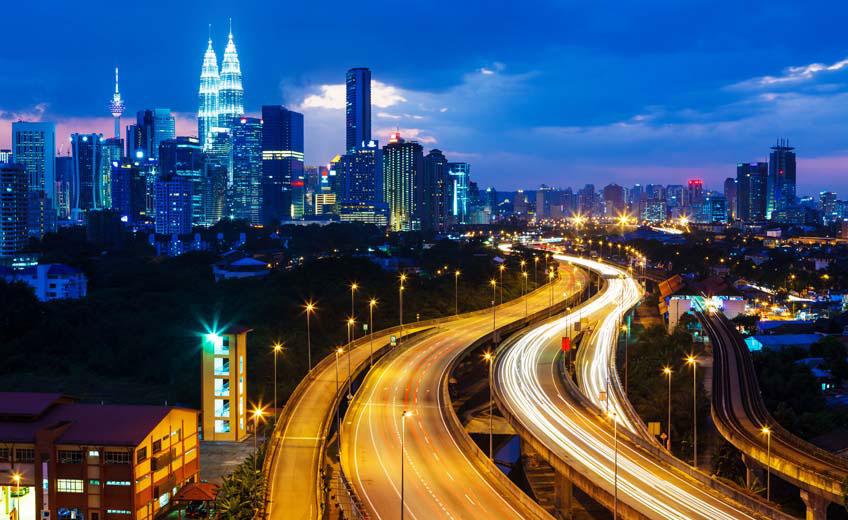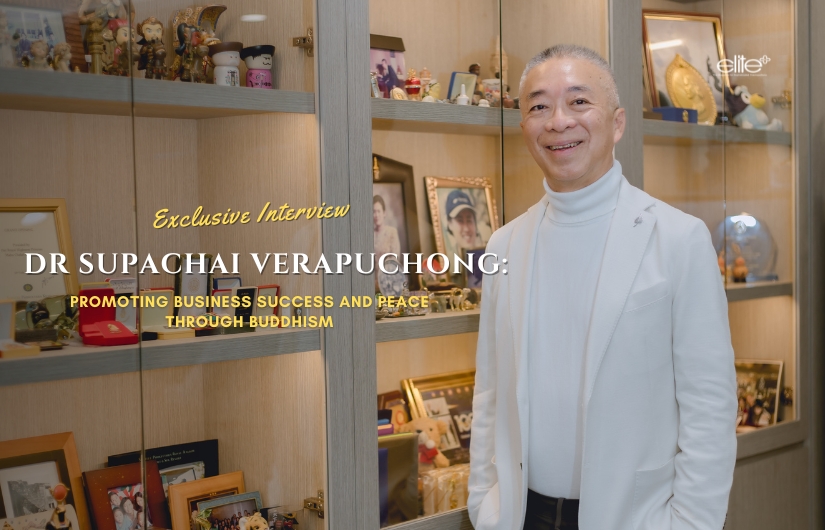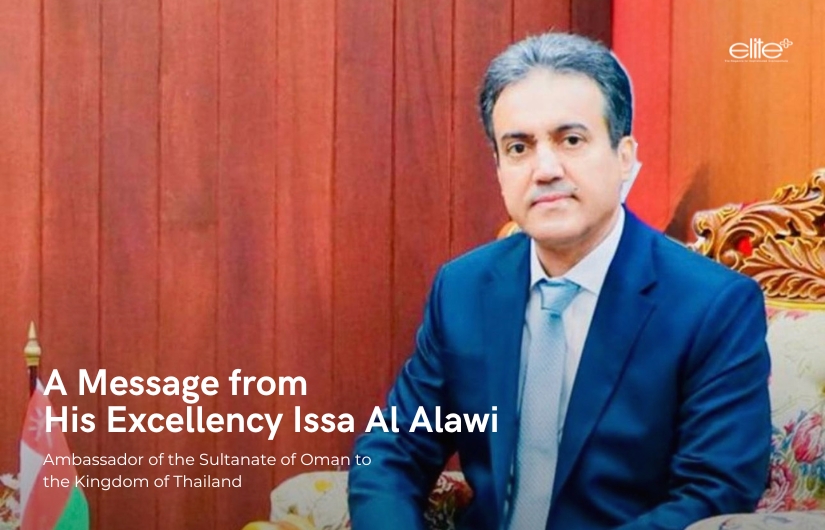Malaysia’s ambassador to Thailand since 2011, Her Excellency Dato’ Nazirah binti Hussain, began her diplomatic career in Australia and has also served and represented her country in China, Singapore and Sri Lanka. An inspiration as a talented woman in a leading role, the humble ambassador spoke to Elite+ about Malaysia’s plans to become a high-income country by 2020, her country’s role in the region and the cultural aspects that have earned Malaysia the slogan “Truly Asia”.
What are the most important economic sectors contributing to Malaysia’s GDP?
The first three economic sectors are services (55.3%), manufacturing (24.6%) and mining (7.9%). Services include tourism and hospitality, medical tourism, education, logistics and so on. We export electronics, petroleum and chemical products, as well as medical and scientific equipment. Agriculture contributes less to GDP yet we grow a lot of palm and rubber trees.
What is the government’s long-term plan for economic development?
We want to become a developed or high-income country by 2020. That’s in our current national development plan, or the Eleventh Malaysia Plan (RMK 11). To achieve that, we have implemented the Government Transformation Programme (GTP) and Economic Transformation Programme (ETP). We are working to deliver government services to the people faster but with more efficiency. We are developing all the economic sectors through research and innovation. By the end of the plan, our services sector is poised to achieve 195 billion ringgit (US$48.3 billion) in exports.
Our plan is based on three principles: sustainability, inclusivity and innovation. A sustainable economy is one in which we take care of our environment while developing the country. Inclusivity is ensuring our people have the right skills by investing in training. We want to be less dependent on foreign labour and focus on raising the level of education and skills of our people – growth and higher wages come from increases in productivity. Lastly, we focus not just on innovation but on commercialising innovation.
What segments are open to or incentivised for foreign investors?
In general, we welcome investments that endorse Malaysia’s image as a centre of high technology and global activities. The sectors vastly open are services and manufacturing, e.g. tourism and hospitality, especially eco-tourism, finance and halal-related products. You can see a complete list on the Malaysian Investment Development Authority website (www.mida.gov.my).
For incentives, the basic package includes corporate tax exemption accorded under pioneer status (PS) and investment tax allowance (ITA), of which the threshold is determined based dedicated corridors, industrial parks and free [trade] zones which are formulated to assist potential investors.
We offer incentives not only for the investors themselves but also the families living in Malaysia, e.g. we endorse their children pursuing the education they need. on the merit of each project. There are also specific fiscal and non-fiscal incentives given to

What large infrastructure projects are currently being developed?
Roads, railways, ports and airports will continue to be constructed in our country. At the same time, we have several joint projects with other governments. Malaysia and Singapore are about to start construction of the Kuala Lumpur-Singapore High-Speed Rail, which will take travel to less than one hour between the two terminals. We have had several infrastructure projects and more to come with Thailand to develop better linkage in the border area, like bridges and bigger roads. This infrastructure has helped facilitate tourism, trade and commerce in the border area and created more interactions between locals of the two countries.

Any other joint initiatives with Thailand?
Malaysia and Thailand cooperate across a whole range of issues at bilateral, ASEAN, regional and multilateral levels, such as irregular movements of migrants, security cooperation along the border, trade cooperation, education and human resource development. Malaysia is honoured by Thailand’s request to be a facilitator in efforts to bring peace to the South of Thailand. The task has been carried out by organisations like the Joint Development Strategy for Border Areas (JDS) and the General Border Committee (GBC).
Thailand is Malaysia’s fifth largest trading partner overall and second largest among ASEAN countries. From the Thai perspective, Malaysia is Thailand’s largest trading partner in ASEAN and fourth largest in the world. We import lots of agricultural products like rice and halal food from Thailand.
How are you improving relations and cooperation between Thailand and Malaysia?
I am focusing on promoting people-to-people relations. In education, our team is working on allowing university credits to be transferred for Thai students in Malaysia and vice versa. We are bringing Malaysian interns to work in Thai government agencies and supporting intern exchanges in the private sector. We are planning attractive and practical travel itineraries or routes to promote linkages between Thailand and Malaysia.
What role does Malaysia play in ASEAN?
Malaysia was one of the founding fathers of ASEAN, which continues to be a cornerstone in Malaysia’s foreign policy. We have been actively involved in all ASEAN activities and initiatives, and put forward ASEAN’s interests in relevant international forums to ensure a peaceful, safe and prosperous region for its 630 million people.
Malaysia chaired the ASEAN Summit in 2005 where two notable events took place. First, it led to the first East Asia Summit (EAS), brainchild of the then Malaysian prime minister, Tun Dr Mahathir Muhammad. The EAS brought leaders from 16 countries for dialogue on broad strategic, political and economic issues. Second was the launch of ASEAN Charter, a foundation that provides the legal and institutional framework for ASEAN. And we became the ASEAN chairman again last year. We led the High Level Task Force (HLTF), developing “ASEAN 2025”, which formulates robust and realisable visions for ASEAN for the 10 years to come.
Also we have become mediators for a few disputes in the region. As one of the claimants of the South China Sea ourselves, we hosted a summit on code of conduct in the sea.
What does Malaysia do to promote ecotourism?
We have the National Ecotourism Plan 2016-2025, which formulates strategic directions for ecotourism, which we regard as a way to develop sustainable tourism. The 11th Malaysia Plan also places emphasis on it. The government, hand-in-hand with the people, is working to upgrade and develop more sustainable and environment-friendly ecotourism infrastructure, build capacity, create a market for it and promote. We are aware that close collaborations among local communities, industry players and stakeholders, NGOs and the government are important to foster tourism development that comes with conservation. This is done through buy-in support
and participation of the entire value chain, mobilised through engagement, public education and awareness programmes as well as effective implementation of ecotourism action plans. Our efforts in developing sustainable tourism are recognised globally. Malaysia was awarded “Best Eco-Vacation” at the 5th National Geographic Traveller Awards in 2015.

ASEAN recognises the importance of ecotourism and Malaysia takes that seriously. One of our contributions to ASEAN ecotourism was the formation of the ASEAN Ecotourism Strategic Plan (AESP), which contributes to development of ecotourism in this region.

How would you define the national culture, and what is the government doing to foster or conserve it?
Malaysia is very culturally diverse. Our population, over 30 million people, comprises Malay, Chinese and Indian as well as other ethnicities, each with their unique cultural identities. This makes Malaysia a melting pot of prominent Asian cultures, hence our tagline “Malaysia, Truly Asia”. The interweaving cultural success of Malaysia is due to the country’s constitutional bearing, which recognises that each community has freedom to pursue its own cultural pursuits. And this forms the basis of our overall cultural development.
No effort is spared to ensure that the cultural traditions and heritage of the Malaysian community are not only promoted and practised but continue to flourish. To this end, the National Academy of Arts, Culture and Heritage (ASWARA) ensures that all aspects of Malaysia’s diverse culture are formally taught to the young to become credible arts practitioners who will perpetuate the country’s art heritage.
As Malaysian society undergoes changes and transformation due to the increasing effects and influences of globalisation, the national culture too continues to evolve in such a manner that it has become our very way of life. By embracing our differences and celebrating our diversity we have found harmony, achieved unity and attained strength.




















































































































































































































































































































































































































































































































































































































































































































































































































































































































